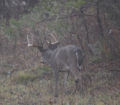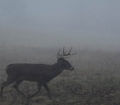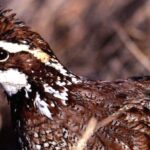John’s Note: Rain, sleet, snow or hail will keep most blackpowder hunters at home and from hunting deer. On the days the weatherman predicts wet weather, I know the lands I hunt will have less hunting pressure from any hunters, particularly from blackpowder hunters. I’ll also have better odds of seeing a deer. During bad weather, I do lose my ability to hear deer walking in the woods, crunching acorns, sparring or grunting – some of the best ways to find deer on still, calm days. I also lose some vision because during rain or snow I usually can’t detect a deer’s tail or ear twitch. However, on rainy days, deer can’t hear, see or even smell as well as I can. Rain provides the best conditions for me to stalk. Deer rarely like to move in the rain. Although I hunt in the rain, I usually hope the rain will stop at some time during the day. When the rain quits, even if only for 30 to 45 minutes, I know the deer generally will move then.
 You’ll find bad-weather bucks patternable. They usually will go to familiar areas to seek shelter from the storm. On many days, I’ll move into thick-cover bedding areas and deliberately jump bucks up. Once I jump a buck out of its bed during bad weather, I mark that spot as a waypoint on my GPS. Then I can call up this GPS reading anytime I hunt the woods during bad weather.
You’ll find bad-weather bucks patternable. They usually will go to familiar areas to seek shelter from the storm. On many days, I’ll move into thick-cover bedding areas and deliberately jump bucks up. Once I jump a buck out of its bed during bad weather, I mark that spot as a waypoint on my GPS. Then I can call up this GPS reading anytime I hunt the woods during bad weather.
Once I know where to find a buck under inclement conditions, I search for the trails he’ll use to get into and out of his bad-weather hide-out. When I find a trail, I take a GPS reading on it and look for a stand site on the edge of the thick cover. Then I mark the stand site as a waypoint on my GPS receiver. Now that I’ve logged in my GPS receiver where to find the buck, which trail he’ll take into that thick cover, and where I’ll put my stand – either going into or coming out of the thick-cover bedding region. I may spend all day trying to jump bucks from their beds during bad-weather conditions. I’ve found I seldom run a large buck out of an area permanently, if I jump him up in bad weather. Because I dress in full camo during pouring-down rain or wear snow camo in the snow, deer likely won’t recognize me as a hunter.
Once I know where the buck goes during bad-weather days, and I have GPS readings on three or four stand sites, I’ll have a game plan for bad-weather blackpowder hunts. This GPS receiver tactic can produce bucks in rain, sleet or snow and gives you an important advantage for navigating during inclement weather. When the clouds hide the sun or snow falls, I can get lost even in familiar terrain. However, with a GPS receiver, I can navigate quickly and efficiently from my vehicle to my bad-weather stand site before daylight, in a driving rainstorm or even in a heavy snow. I believe the GPS receiver opens up a whole new world for the bad-weather hunter. Other than keeping your equipment dry, the same blackpowder tactics that have proved successful for conventional weapons hunters will give you success this season. You’ll find a GPS receiver the best addition you can make to your bad-weather, blackpowder hunting game plan this year. Not only will a GPS receiver help you find better places to hunt and take more deer, it also will ensure your safe return out of the woods regardless of the weather conditions.
 You’ll learn more deer-hunting information and tips from hunters in John E. Phillips’ Kindle, CreateSpace and Audible books. Go to https://johninthewild.com/books/#deer to purchase and download to your Kindle, and/or download a Kindle app for your iPad, SmartPhone or computer. You also can go to Nook Books at www.barnesandnoble.com to buy. Also you can download free books by going to https://johninthewild.com/free-books.
You’ll learn more deer-hunting information and tips from hunters in John E. Phillips’ Kindle, CreateSpace and Audible books. Go to https://johninthewild.com/books/#deer to purchase and download to your Kindle, and/or download a Kindle app for your iPad, SmartPhone or computer. You also can go to Nook Books at www.barnesandnoble.com to buy. Also you can download free books by going to https://johninthewild.com/free-books.










